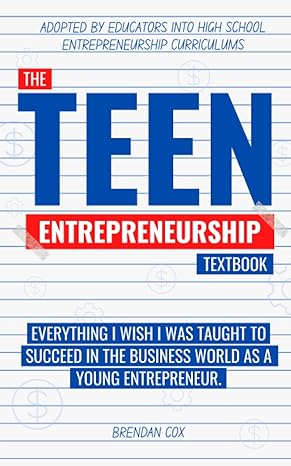*choose any 2 of the student activities to do*

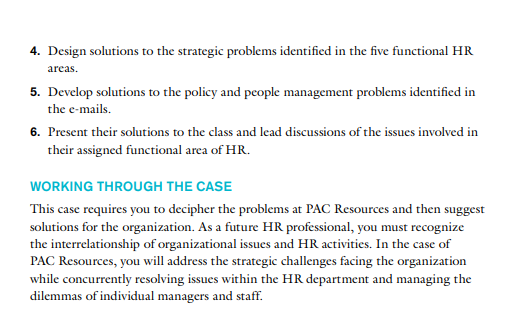
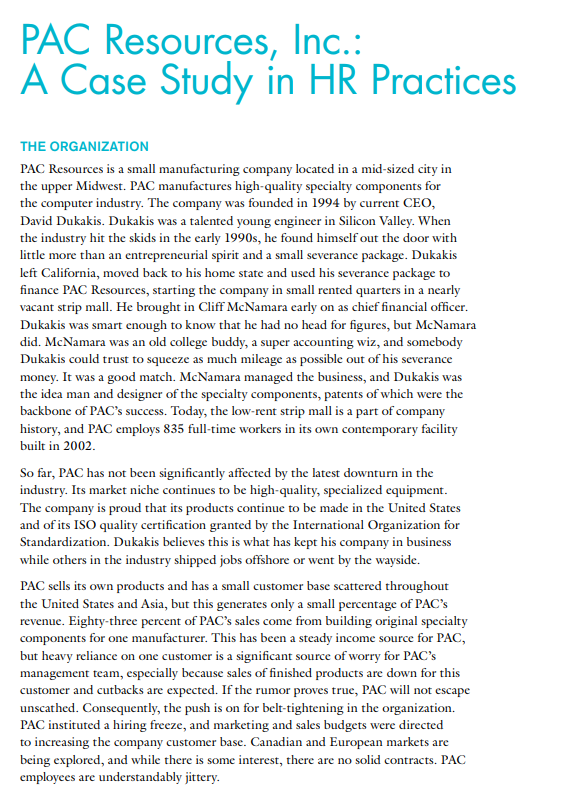
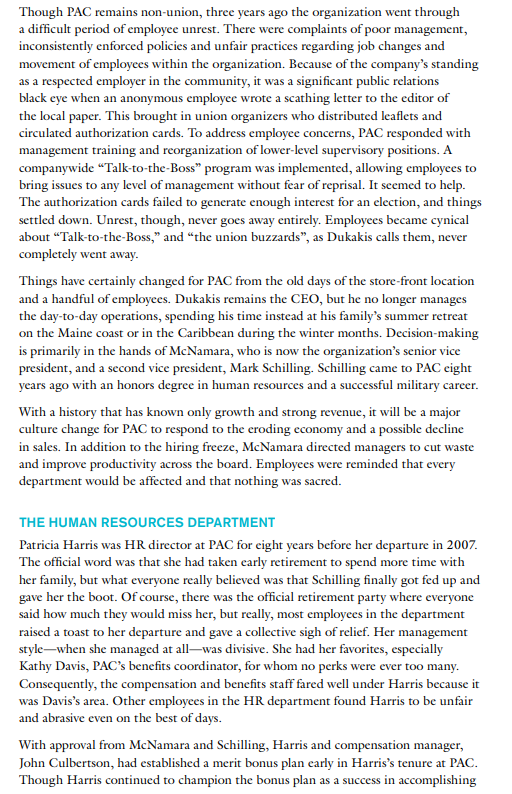
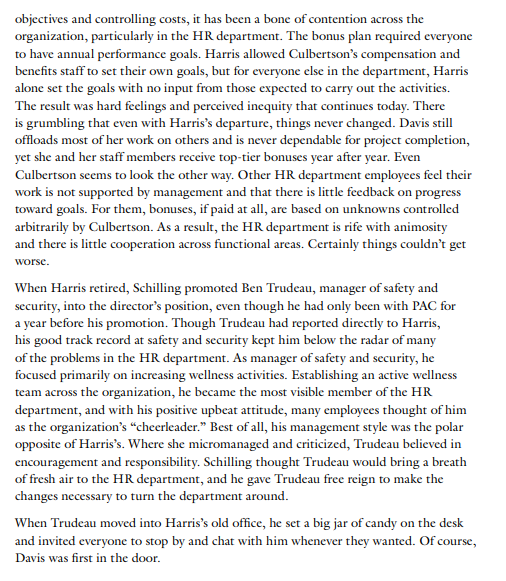

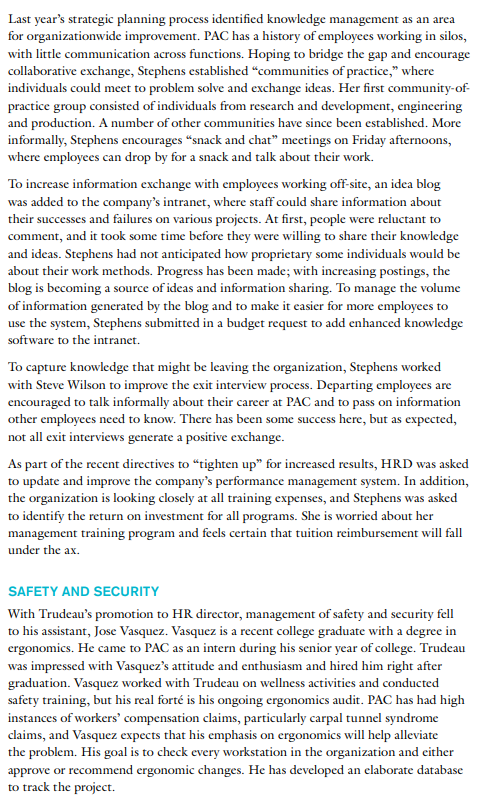
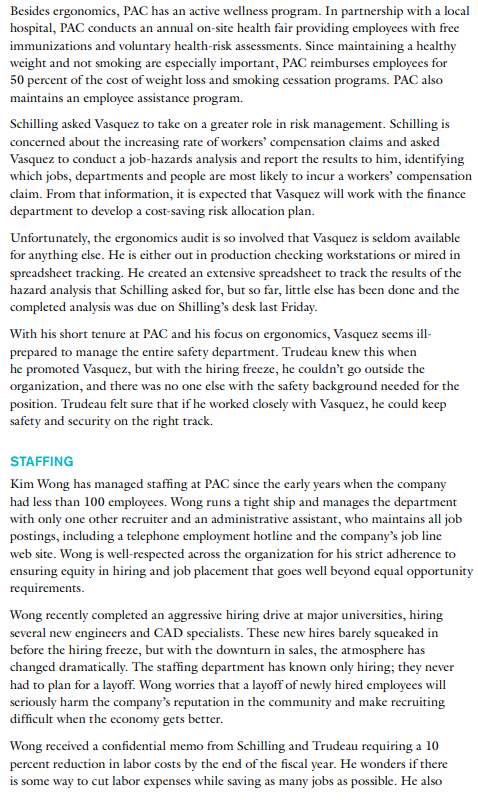
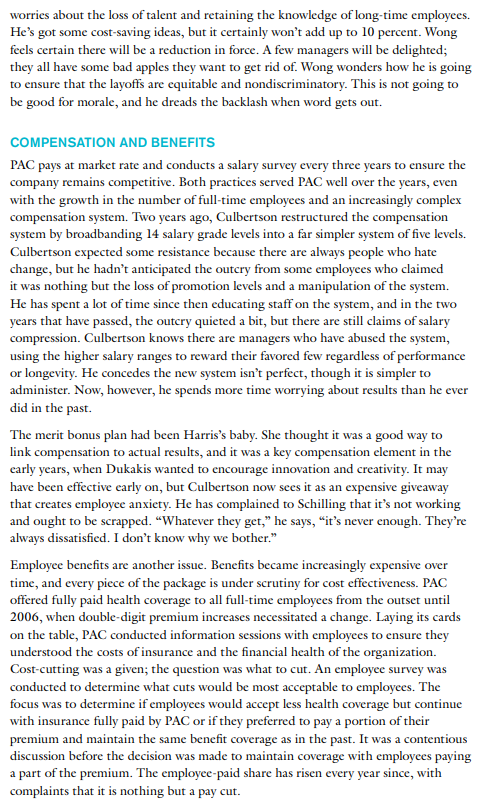
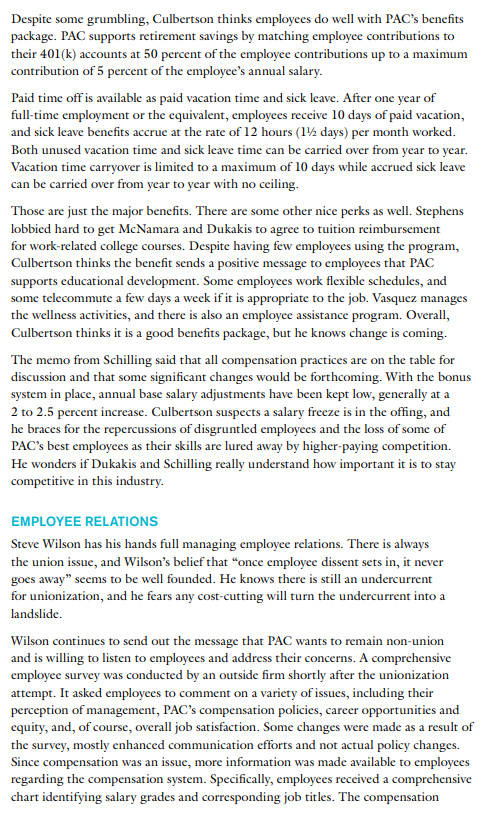
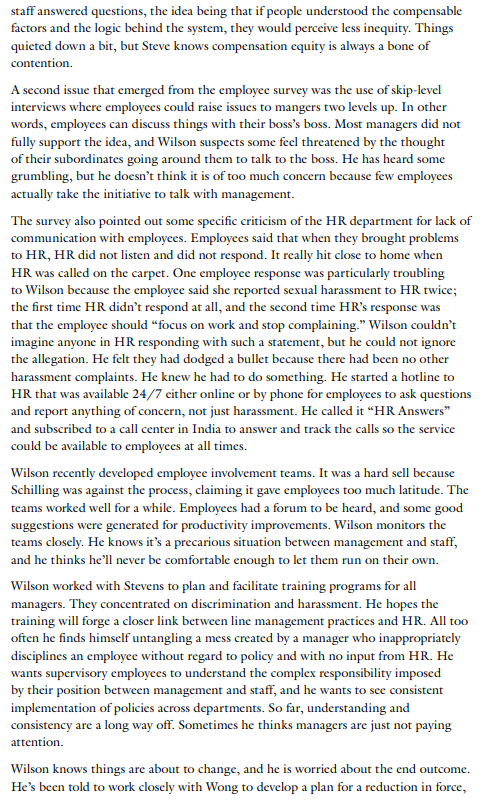
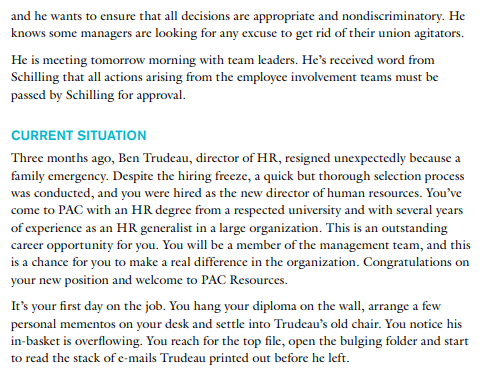
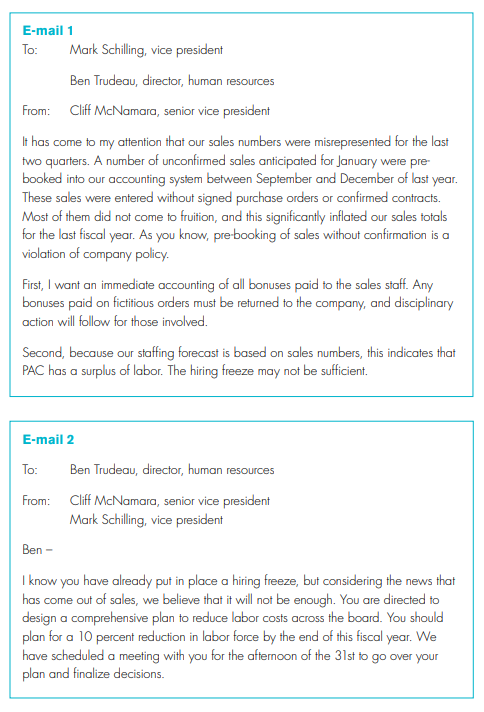
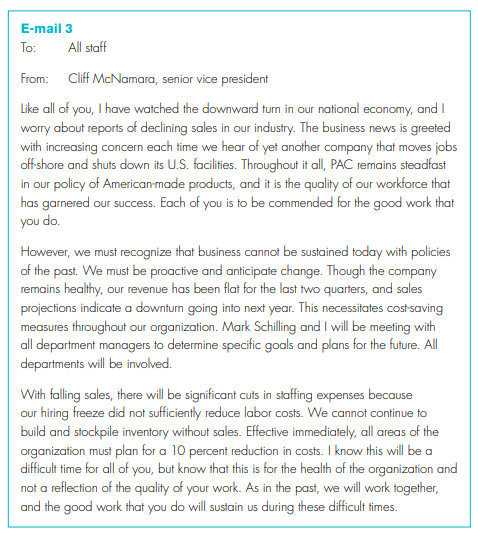

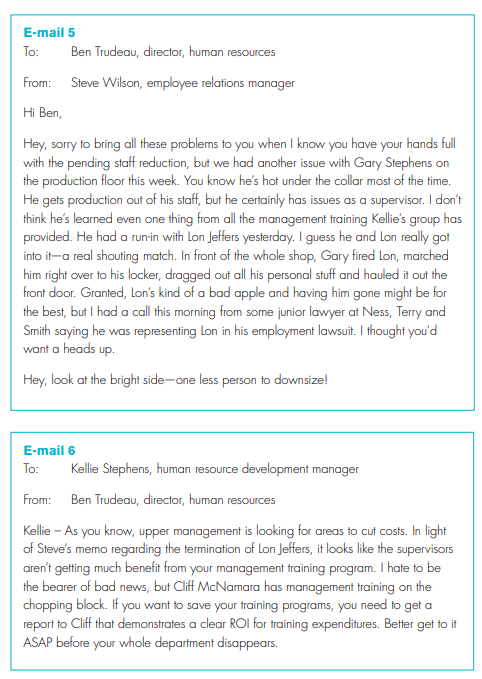
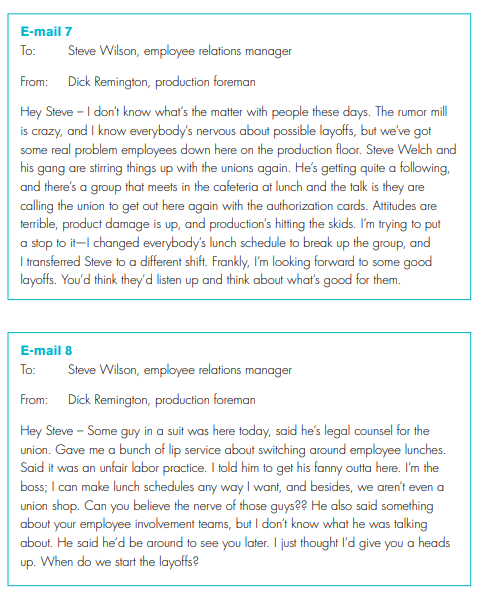
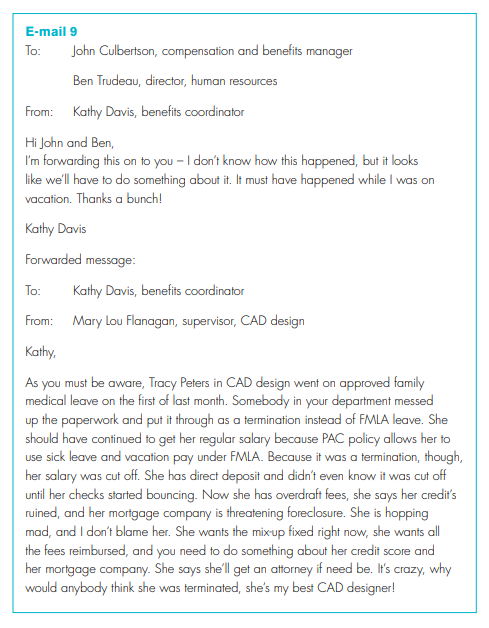

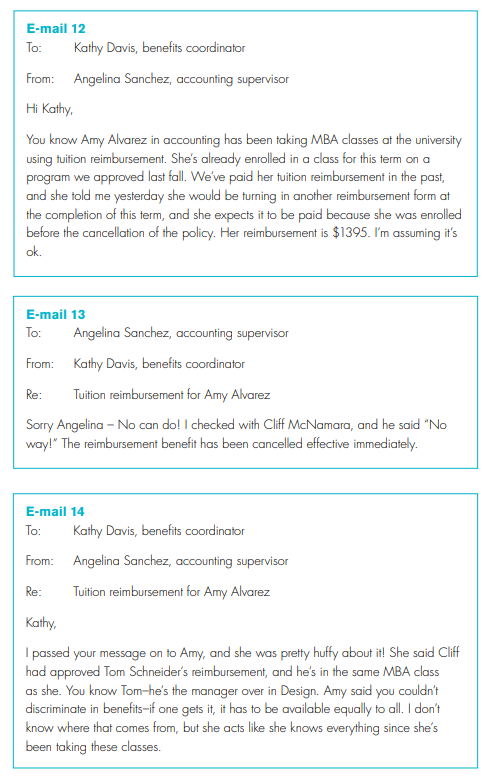
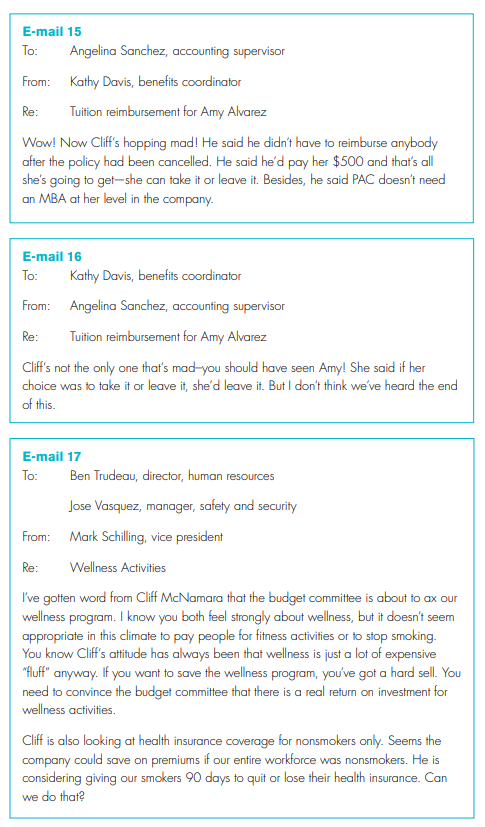
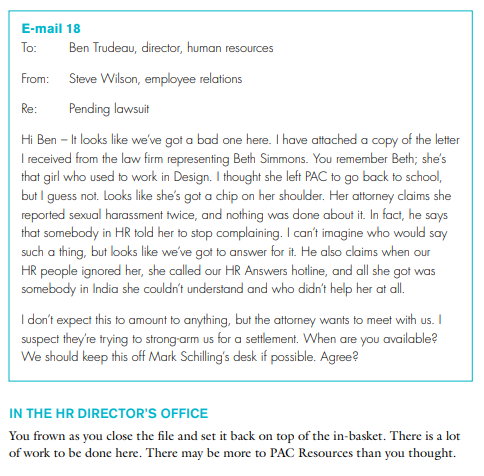
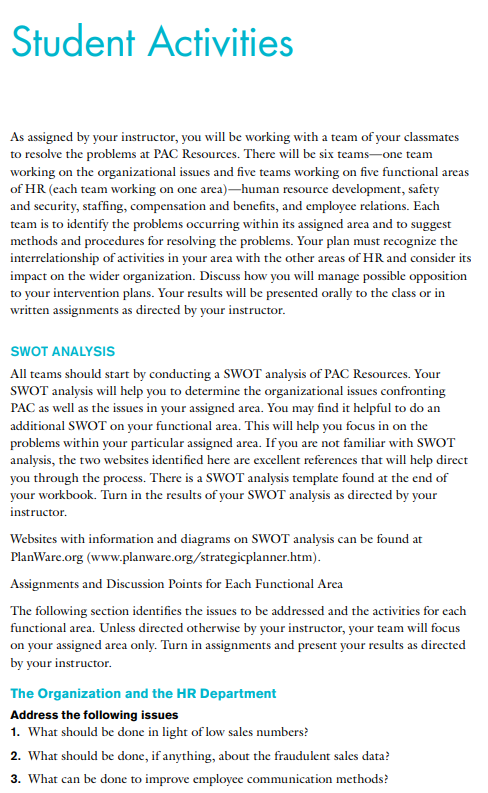
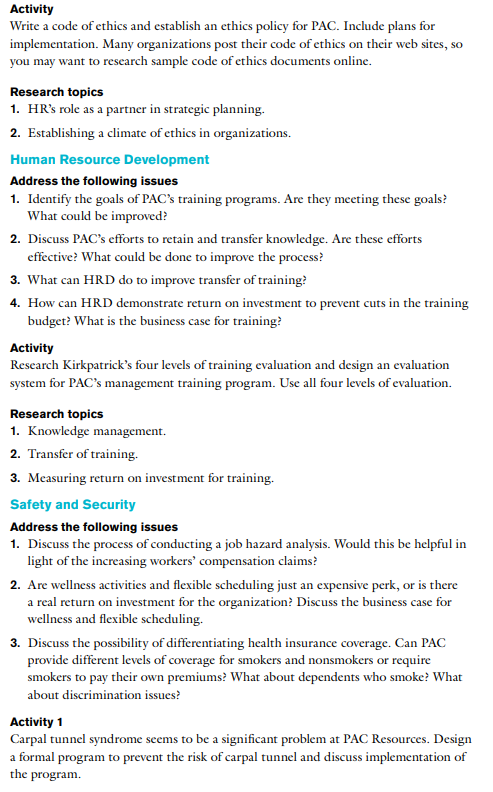
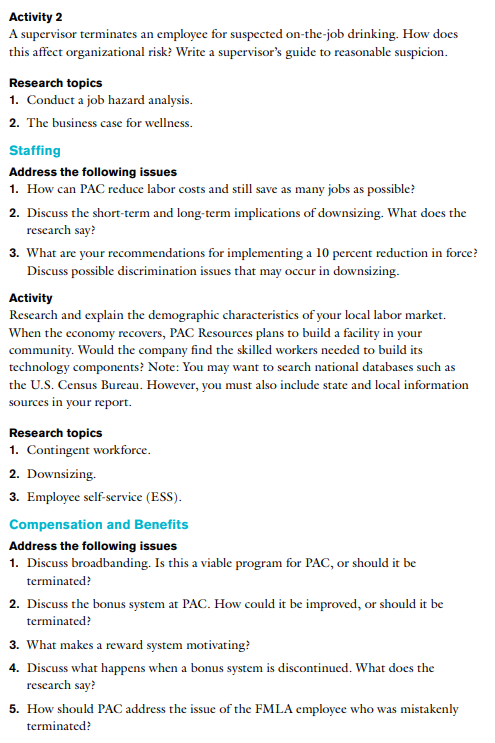

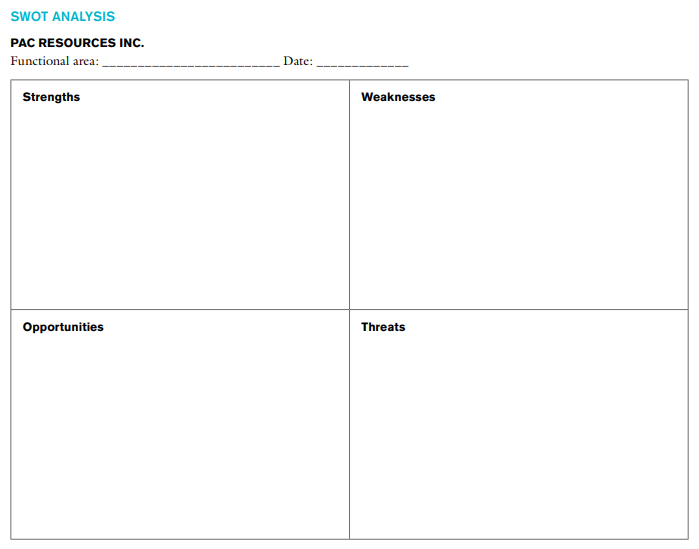
Although PAC Resources is a fictional organization, it experiences many of the difficulties common in today's business climate. In response to declining sales, PAC Resources must transform itself from a strategy of expansion and high profit to one of cost containment and staff reductions. The case is presented in two parts. Part I lays the groundwork for the case, with discussion of the organization and details of the human resource department. Part II is presented in e-mails from various staff members. The e-mails identify specific problems that need to be addressed by the HR department and give the reader an understanding of PAC's overall culture. PRE-REQUISITES Resolving the case of PAC Resources requires you to have fundamental knowledge of human resource practices and general business management. You should have previously completed lower-division classes in human resource management, introduction to business and principles of management. OBJECTIVES In this case, you will: 1. Recognize the link between organization strategy and human resource activities. 2. Conduct a SWOT analysis of the organization with emphasis on the HR department. 3. Indentify problem areas in each of these five functional areas of HR Management: - Human resource development. - Safety and security. - Staffing. - Compensation and benefits. - Employee relations. 4. Design solutions to the strategic problems identified in the five functional HR areas. 5. Develop solutions to the policy and people management problems identified in the e-mails. 6. Present their solutions to the class and lead discussions of the issues involved in their assigned functional area of HR. WORKING THROUGH THE CASE This case requires you to decipher the problems at PAC Resources and then suggest solutions for the organization. As a future HR professional, you must recognize the interrelationship of organizational issues and HR activities. In the case of PAC Resources, you will address the strategic challenges facing the organization while concurrently resolving issues within the HR department and managing the dilemmas of individual managers and staff. PAC Resources, Inc.: A Case Study in HR Practices THE ORGANIZATION PAC Resources is a small manufacturing company located in a mid-sized city in the upper Midwest. PAC manufactures high-quality specialty components for the computer industry. The company was founded in 1994 by current CEO, David Dukakis. Dukakis was a talented young engineer in Silicon Valley. When the industry hit the skids in the early 1990s, he found himself out the door with little more than an entrepreneurial spirit and a small severance package. Dukakis left California, moved back to his home state and used his severance package to finance PAC Resources, starting the company in small rented quarters in a nearly vacant strip mall. He brought in Cliff McNamara early on as chief financial officer. Dukakis was smart enough to know that he had no head for figures, but McNamara did. McNamara was an old college buddy, a super accounting wiz, and somebody Dukakis could trust to squeeze as much mileage as possible out of his severance money. It was a good match. McNamara managed the business, and Dukakis was the idea man and designer of the specialty components, patents of which were the backbone of PAC's success. Today, the low-rent strip mall is a part of company history, and PAC employs 835 full-time workers in its own contemporary facility built in 2002. So far, PAC has not been significantly affected by the latest downturn in the industry. Its market niche continues to be high-quality, specialized equipment. The company is proud that its products continue to be made in the United States and of its ISO quality certification granted by the International Organization for Standardization. Dukakis believes this is what has kept his company in business while others in the industry shipped jobs offshore or went by the wayside. PAC sells its own products and has a small customer base scattered throughout the United States and Asia, but this generates only a small percentage of PAC's revenue. Eighty-three percent of PAC's sales come from building original specialty components for one manufacturer. This has been a steady income source for PAC, but heavy reliance on one customer is a significant source of worry for PAC's management team, especially because sales of finished products are down for this customer and cutbacks are expected. If the rumor proves true, PAC will not escape unscathed. Consequently, the push is on for belt-tightening in the organization. PAC instituted a hiring freeze, and marketing and sales budgets were directed to increasing the company customer base. Canadian and European markets are being explored, and while there is some interest, there are no solid contracts. PAC employees are understandably jittery. Though PAC remains non-union, three years ago the organization went through a difficult period of employee unrest. There were complaints of poor management, inconsistently enforced policies and unfair practices regarding job changes and movement of employees within the organization. Because of the company's standing as a respected employer in the community, it was a significant public relations black eye when an anonymous employee wrote a scathing letter to the editor of the local paper. This brought in union organizers who distributed leaflets and circulated authorization cards. To address employee concerns, PAC responded with management training and reorganization of lower-level supervisory positions. A companywide "Talk-to-the-Boss" program was implemented, allowing employees to bring issues to any level of management without fear of reprisal. It seemed to help. The authorization cards failed to generate enough interest for an election, and things settled down. Unrest, though, never goes away entirely. Employees became cynical about "Talk-to-the-Boss," and "the union buzzards", as Dukakis calls them, never completely went away. Things have certainly changed for PAC from the old days of the store-front location and a handful of employees. Dukakis remains the CEO, but he no longer manages the day-to-day operations, spending his time instead at his family's summer retreat on the Maine coast or in the Caribbean during the winter months. Decision-making is primarily in the hands of McNamara, who is now the organization's senior vice president, and a second vice president, Mark Schilling. Schilling came to PAC eight years ago with an honors degree in human resources and a successful military career. With a history that has known only growth and strong revenue, it will be a major culture change for PAC to respond to the eroding economy and a possible decline in sales. In addition to the hiring freeze, McNamara directed managers to cut waste and improve productivity across the board. Employees were reminded that every department would be affected and that nothing was sacred. THE HUMAN RESOURCES DEPARTMENT Patricia Harris was HR director at PAC for eight years before her departure in 2007. The official word was that she had taken early retirement to spend more time with her family, but what everyone really believed was that Schilling finally got fed up and gave her the boot. Of course, there was the official retirement party where everyone said how much they would miss her, but really, most employees in the department raised a toast to her departure and gave a collective sigh of relief. Her management style-when she managed at all-was divisive. She had her favorites, especially Kathy Davis, PAC's benefits coordinator, for whom no perks were ever too many. Consequently, the compensation and benefits staff fared well under Harris because it was Davis's area. Other employees in the HR department found Harris to be unfair and abrasive even on the best of days. With approval from McNamara and Schilling, Harris and compensation manager, John Culbertson, had established a merit bonus plan early in Harris's tenure at PAC. Though Harris continued to champion the bonus plan as a success in accomplishing objectives and controlling costs, it has been a bone of contention across the organization, particularly in the HR department. The bonus plan required everyone to have annual performance goals. Harris allowed Culbertson's compensation and benefits staff to set their own goals, but for everyone else in the department, Harris alone set the goals with no input from those expected to carry out the activities. The result was hard feelings and perceived inequity that continues today. There is grumbling that even with Harris's departure, things never changed. Davis still offloads most of her work on others and is never dependable for project completion, yet she and her staff members receive top-tier bonuses year after year. Even Culbertson seems to look the other way. Other HR department employees feel their work is not supported by management and that there is little feedback on progress toward goals. For them, bonuses, if paid at all, are based on unknowns controlled arbitrarily by Culbertson. As a result, the HR department is rife with animosity and there is little cooperation across functional areas. Certainly things couldn't get worse. When Harris retired, Schilling promoted Ben Trudeau, manager of safety and security, into the director's position, even though he had only been with PAC for a year before his promotion. Though Trudeau had reported directly to Harris, his good track record at safety and security kept him below the radar of many of the problems in the HR department. As manager of safety and security, he focused primarily on increasing wellness activities. Establishing an active wellness team across the organization, he became the most visible member of the HR department, and with his positive upbeat attitude, many employees thought of him as the organization's "cheerleader." Best of all, his management style was the polar opposite of Harris's. Where she micromanaged and criticized, Trudeau believed in encouragement and responsibility. Schilling thought Trudeau would bring a breath of fresh air to the HR department, and he gave Trudeau free reign to make the changes necessary to turn the department around. When Trudeau moved into Harris's old office, he set a big jar of candy on the desk and invited everyone to stop by and chat with him whenever they wanted. Of course, Davis was first in the door. HR Director: Ben Trudeau HRD Manager: Kellie Stephens Compensation and Benefits Manager: John Culbertson Benefits Coordinator: Kathy Davis Staffing Manager: Kim Wong Safety and Security Manager: Jose Vasquez Employee Relations Manager: Steve Wilson HUMAN RESOURCE DEVELOPMENT The HRD division is managed by training director Kellie Stephens, who supervises two other employees: a trainer and an administrative assistant, who coordinate the logistics of PAC's training programs. Recognizing the continuous dynamics of the high-tech industry, PAC has been a strong supporter of employee development. With approval of the immediate supervisor, PAC encourages employees to attend training seminars, and tuition reimbursement is available for college-level courses that are related to the employee's job. In-house training is conducted regularly to ensure all employees are up-to-date on sexual harassment and safety procedures. Other training is made available as the need arises. Whenever possible, training programs are developed and facilitated by in-house staff members. When that is not practicable, a request for proposal is generated and PAC hires outside facilitators. Since the labor problem a few years back, Stephens aggressively trained management employees with particular emphasis on skills for first-line supervisors. She wants to see improvement in people skills and consistent implementation of PAC policies across department lines. Unfortunately, her efforts are not universally well received. Some managers grumble that HR just gets in the way and ties their hands when dealing with difficult employees. All too often Stephens hears managers say that there is the "classroom way" and the "shop floor way." She sees training for PAC managers as an ongoing process. Last year's strategic planning process identified knowledge management as an area for organizationwide improvement. PAC has a history of employees working in silos, with little communication across functions. Hoping to bridge the gap and encourage collaborative exchange, Stephens established "communities of practice," where individuals could meet to problem solve and exchange ideas. Her first community-ofpractice group consisted of individuals from research and development, engineering and production. A number of other communities have since been established. More informally, Stephens encourages "snack and chat" meetings on Friday afternoons, where employees can drop by for a snack and talk about their work. To increase information exchange with employees working off-site, an idea blog was added to the company's intranet, where staff could share information about their successes and failures on various projects. At first, people were reluctant to comment, and it took some time before they were willing to share their knowledge and ideas. Stephens had not anticipated how proprietary some individuals would be about their work methods. Progress has been made; with increasing postings, the blog is becoming a source of ideas and information sharing. To manage the volume of information generated by the blog and to make it easier for more employees to use the system, Stephens submitted in a budget request to add enhanced knowledge software to the intranet. To capture knowledge that might be leaving the organization, Stephens worked with Steve Wilson to improve the exit interview process. Departing employees are encouraged to talk informally about their career at PAC and to pass on information other employees need to know. There has been some success here, but as expected, not all exit interviews generate a positive exchange. As part of the recent directives to "tighten up" for increased results, HRD was asked to update and improve the company's performance management system. In addition, the organization is looking closely at all training expenses, and Stephens was asked to identify the return on investment for all programs. She is worried about her management training program and feels certain that tuition reimbursement will fall under the ax. SAFETY AND SECURITY With Trudeau's promotion to HR director, management of safety and security fell to his assistant, Jose Vasquez. Vasquez is a recent college graduate with a degree in ergonomics. He came to PAC as an intern during his senior year of college. Trudeau was impressed with Vasquez's attitude and enthusiasm and hired him right after graduation. Vasquez worked with Trudeau on wellness activities and conducted safety training, but his real fort is his ongoing ergonomics audit. PAC has had high instances of workers' compensation claims, particularly carpal tunnel syndrome claims, and Vasquez expects that his emphasis on ergonomics will help alleviate the problem. His goal is to check every workstation in the organization and either approve or recommend ergonomic changes. He has developed an elaborate database to track the project. Besides ergonomics, PAC has an active wellness program. In partnership with a local hospital, PAC conducts an annual on-site health fair providing employees with free immunizations and voluntary health-risk assessments. Since maintaining a healthy weight and not smoking are especially important, PAC reimburses employees for 50 percent of the cost of weight loss and smoking cessation programs. PAC also maintains an employee assistance program. Schilling asked Vasquez to take on a greater role in risk management. Schilling is concerned about the increasing rate of workers' compensation claims and asked Vasquez to conduct a job-hazards analysis and report the results to him, identifying which jobs, departments and people are most likely to incur a workers' compensation claim. From that information, it is expected that Vasquez will work with the finance department to develop a cost-saving risk allocation plan. Unfortunately, the ergonomics audit is so involved that Vasquez is seldom available for anything else. He is either out in production checking workstations or mired in spreadsheet tracking. He created an extensive spreadsheet to track the results of the hazard analysis that Schilling asked for, but so far, little else has been done and the completed analysis was due on Shilling's desk last Friday. With his short tenure at PAC and his focus on ergonomics, Vasquez seems illprepared to manage the entire safety department. Trudeau knew this when he promoted Vasquez, but with the hiring freeze, he couldn't go outside the organization, and there was no one else with the safety background needed for the position. Trudeau felt sure that if he worked closely with Vasquez, he could keep safety and security on the right track. STAFFING Kim Wong has managed staffing at PAC since the early years when the company had less than 100 employees. Wong runs a tight ship and manages the department with only one other recruiter and an administrative assistant, who maintains all job postings, including a telephone employment hotline and the company's job line web site. Wong is well-respected across the organization for his strict adherence to ensuring equity in hiring and job placement that goes well beyond equal opportunity requirements. Wong recently completed an aggressive hiring drive at major universities, hiring several new engineers and CAD specialists. These new hires barely squeaked in before the hiring freeze, but with the downturn in sales, the atmosphere has changed dramatically. The staffing department has known only hiring; they never had to plan for a layoff. Wong worries that a layoff of newly hired employees will seriously harm the company's reputation in the community and make recruiting difficult when the economy gets better. Wong received a confidential memo from Schilling and Trudeau requiring a 10 percent reduction in labor costs by the end of the fiscal year. He wonders if there is some way to cut labor expenses while saving as many jobs as possible. He also worries about the loss of talent and retaining the knowledge of long-time employees. He's got some cost-saving ideas, but it certainly won't add up to 10 percent. Wong feels certain there will be a reduction in force. A few managers will be delighted; they all have some bad apples they want to get rid of. Wong wonders how he is going to ensure that the layoffs are equitable and nondiscriminatory. This is not going to be good for morale, and he dreads the backlash when word gets out. COMPENSATION AND BENEFITS PAC pays at market rate and conducts a salary survey every three years to ensure the company remains competitive. Both practices served PAC well over the years, even with the growth in the number of full-time employees and an increasingly complex compensation system. Two years ago, Culbertson restructured the compensation system by broadbanding 14 salary grade levels into a far simpler system of five levels. Culbertson expected some resistance because there are always people who hate change, but he hadn't anticipated the outcry from some employees who claimed it was nothing but the loss of promotion levels and a manipulation of the system. He has spent a lot of time since then educating staff on the system, and in the two years that have passed, the outcry quieted a bit, but there are still claims of salary compression. Culbertson knows there are managers who have abused the system, using the higher salary ranges to reward their favored few regardless of performance or longevity. He concedes the new system isn't perfect, though it is simpler to administer. Now, however, he spends more time worrying about results than he ever did in the past. The merit bonus plan had been Harris's baby. She thought it was a good way to link compensation to actual results, and it was a key compensation element in the early years, when Dukakis wanted to encourage innovation and creativity. It may have been effective early on, but Culbertson now sees it as an expensive giveaway that creates employee anxiety. He has complained to Schilling that it's not working and ought to be scrapped. "Whatever they get," he says, "it's never enough. They're always dissatisfied. I don't know why we bother." Employee benefits are another issue. Benefits became increasingly expensive over time, and every piece of the package is under scrutiny for cost effectiveness. PAC offered fully paid health coverage to all full-time employees from the outset until 2006, when double-digit premium increases necessitated a change. Laying its cards on the table, PAC conducted information sessions with employees to ensure they understood the costs of insurance and the financial health of the organization. Cost-cutting was a given; the question was what to cut. An employee survey was conducted to determine what cuts would be most acceptable to employees. The focus was to determine if employees would accept less health coverage but continue with insurance fully paid by PAC or if they preferred to pay a portion of their premium and maintain the same benefit coverage as in the past. It was a contentious discussion before the decision was made to maintain coverage with employees paying a part of the premium. The employee-paid share has risen every year since, with complaints that it is nothing but a pay cut. package. PAC supports retirement savings by matching employee contributions to their 401(k) accounts at 50 percent of the employee contributions up to a maximum contribution of 5 percent of the employee's annual salary. Paid time off is available as paid vacation time and sick leave. After one year of full-time employment or the equivalent, employees receive 10 days of paid vacation, Both unused vacation time and sick leave time can be carried over from year to year. Vacation time carryover is limited to a maximum of 10 days while accrued sick leave can be carried over from year to year with no ceiling. Those are just the major benefits. There are some other nice perks as well. Stephens lobbied hard to get McNamara and Dukakis to agree to tuition reimbursement for work-related college courses. Despite having few employees using the program, Culbertson thinks the benefit sends a positive message to employees that PAC supports educational development. Some employees work flexible schedules, and some telecommute a few days a week if it is appropriate to the job. Vasquez manages the wellness activities, and there is also an employee assistance program. Overall, Culbertson thinks it is a good benefits package, but he knows change is coming. The memo from Schilling said that all compensation practices are on the table for discussion and that some significant changes would be forthcoming. With the bonus system in place, annual base salary adjustments have been kept low, generally at a 2 to 2.5 percent increase. Culbertson suspects a salary freeze is in the offing, and he braces for the repercussions of disgruntled employees and the loss of some of PAC's best employees as their skills are lured away by higher-paying competition. He wonders if Dukakis and Schilling really understand how important it is to stay competitive in this industry. EMPLOYEE RELATIONS Steve Wilson has his hands full managing employee relations. There is always the union issue, and Wilson's belief that "once employee dissent sets in, it never goes away" seems to be well founded. He knows there is still an undercurrent for unionization, and he fears any cost-cutting will turn the undercurrent into a landslide. Wilson continues to send out the message that PAC wants to remain non-union and is willing to listen to employees and address their concerns. A comprehensive employee survey was conducted by an outside firm shortly after the unionization attempt. It asked employees to comment on a variety of issues, including their perception of management, PAC's compensation policies, career opportunities and equity, and, of course, overall job satisfaction. Some changes were made as a result of the survey, mostly enhanced communication efforts and not actual policy changes. Since compensation was an issue, more information was made available to employees regarding the compensation system. Specifically, employees received a comprehensive chart identifying salary grades and corresponding job titles. The compensation staff answered questions, the idea being that if people understood the compensable factors and the logic behind the system, they would perceive less inequity. Things quieted down a bit, but Steve knows compensation equity is always a bone of contention. A second issue that emerged from the employee survey was the use of skip-level interviews where employees could raise issues to mangers two levels up. In other words, employees can discuss things with their boss's boss. Most managers did not fully support the idea, and Wilson suspects some feel threatened by the thought of their subordinates going around them to talk to the boss. He has heard some grumbling, but he doesn't think it is of too much concern because few employees actually take the initiative to talk with management. The survey also pointed out some specific criticism of the HR department for lack of communication with employees. Employees said that when they brought problems to HR, HR did not listen and did not respond. It really hit close to home when HR was called on the carpet. One employee response was particularly troubling to Wilson because the employee said she reported sexual harassment to HR twice; the first time HR didn't respond at all, and the second time HR's response was that the employee should "focus on work and stop complaining." Wilson couldn't imagine anyone in HR responding with such a statement, but he could not ignore the allegation. He felt they had dodged a bullet because there had been no other harassment complaints. He knew he had to do something. He started a hotline to HR that was available 24/7 either online or by phone for employees to ask questions and report anything of concern, not just harassment. He called it "HR Answers" and subscribed to a call center in India to answer and track the calls so the service could be available to employees at all times. Wilson recently developed employee involvement teams. It was a hard sell because Schilling was against the process, claiming it gave employees too much latitude. The teams worked well for a while. Employees had a forum to be heard, and some good suggestions were generated for productivity improvements. Wilson monitors the teams closely. He knows it's a precarious situation between management and staff, and he thinks he'll never be comfortable enough to let them run on their own. Wilson worked with Stevens to plan and facilitate training programs for all managers. They concentrated on discrimination and harassment. He hopes the training will forge a closer link between line management practices and HR. All too often he finds himself untangling a mess created by a manager who inappropriately disciplines an employee without regard to policy and with no input from HR. He wants supervisory employees to understand the complex responsibility imposed by their position between management and staff, and he wants to see consistent implementation of policies across departments. So far, understanding and consistency are a long way off. Sometimes he thinks managers are just not paying attention. Wilson knows things are about to change, and he is worried about the end outcome. He's been told to work closely with Wong to develop a plan for a reduction in force, and he wants to ensure that all decisions are appropriate and nondiscriminatory. He knows some managers are looking for any excuse to get rid of their union agitators. He is meeting tomorrow morning with team leaders. He's received word from Schilling that all actions arising from the employee involvement teams must be passed by Schilling for approval. CURRENT SITUATION Three months ago, Ben Trudeau, director of HR, resigned unexpectedly because a family emergency. Despite the hiring freeze, a quick but thorough selection process was conducted, and you were hired as the new director of human resources. You've come to PAC with an HR degree from a respected university and with several years of experience as an HR generalist in a large organization. This is an outstanding career opportunity for you. You will be a member of the management team, and this is a chance for you to make a real difference in the organization. Congratulations on your new position and welcome to PAC Resources. It's your first day on the job. You hang your diploma on the wall, arrange a few personal mementos on your desk and settle into Trudeau's old chair. You notice his in-basket is overflowing. You reach for the top file, open the bulging folder and start to read the stack of e-mails Trudeau printed out before he left. E-mail 1 To: Mark Schilling, vice president Ben Trudeau, director, human resources From: Cliff McNamara, senior vice president It has come to my attention that our sales numbers were misrepresented for the last two quarters. A number of unconfirmed sales anticipated for January were prebooked into our accounting system between September and December of last year. These sales were entered without signed purchase orders or confirmed contracts. Most of them did not come to fruition, and this significantly inflated our sales totals for the last fiscal year. As you know, pre-booking of sales without confirmation is a violation of company policy. First, I want an immediate accounting of all bonuses paid to the sales staff. Any bonuses paid on fictitious orders must be returned to the company, and disciplinary action will follow for those involved. Second, because our staffing forecast is based on sales numbers, this indicates that PAC has a surplus of labor. The hiring freeze may not be sufficient. E-mail 2 To: Ben Trudeau, director, human resources From: Cliff McNamara, senior vice president Mark Schilling, vice president Ben - I know you have already put in place a hiring freeze, but considering the news that has come out of sales, we believe that it will not be enough. You are directed to design a comprehensive plan to reduce labor costs across the board. You should plan for a 10 percent reduction in labor force by the end of this fiscal year. We have scheduled a meeting with you for the afternoon of the 31 st to go over your plan and finalize decisions. E-mail 3 To: All staff From: Cliff McNamara, senior vice president Like all of you, I have watched the downward turn in our national economy, and I worry about reports of declining sales in our indusiry. The business news is greeted with increasing concern each time we hear of yet another company that moves jobs off-shore and shuts down its U.S. facilities. Throughout it all, PAC remains steadfast in our policy of American-made products, and it is the quality of our workforce that has garnered our success. Each of you is to be commended for the good work that you do. However, we must recognize that business cannot be sustained today with policies of the past. We must be proactive and anticipate change. Though the company remains healthy, our revenue has been flat for the last two quarters, and sales projections indicate a downturn going into next year. This necessitates cost-saving measures throughout our organization. Mark Schilling and I will be meeting with all department managers to determine specific goals and plans for the future. All departments will be involved. With falling sales, there will be significant cuts in staffing expenses because our hiring freeze did not sufficiently reduce labor costs. We cannot continue to build and stockpile inventory without sales. Effective immediately, all areas of the organization must plan for a 10 percent reduction in costs. I know this will be a difficult time for all of you, but know that this is for the health of the organization and not a reflection of the quality of your work. As in the past, we will work together, and the good work that you do will sustain us during these difficult times. E-mail 4 To: Ben Trudeau, director, human resources From: John Culbertson, compensation and benefits manager Ben, I'm sending this on to you because I don't know what to tell her. Do we have a policy on this? John Forwarded message: To: John Culbertson, compensation and benefits manager From: Kathy Davis, benefits coordinator Hey John - I just got back from vacation today, and I wish I could say I had a great time and was well-rested and ready to hit the ground running, but unfortunately I was sick for 10 days of my two-week vacation. What a bummer and a lousy way to burn up all my vacation time! Since I have unused sick time available, can I change the 10 days of vacation to 10 days of sick leave so I can take a vacation when l'm not sick? Thanks for doing the paperwork for me! E-mail 5 To: Ben Trudeau, director, human resources From: Steve Wilson, employee relations manager Hi Ben, Hey, sorry to bring all these problems to you when I know you have your hands full with the pending staff reduction, but we had another issue with Gary Stephens on the production floor this week. You know he's hot under the collar most of the time. He gets production out of his staff, but he certainly has issues as a supervisor. I don't think he's learned even one thing from all the management training Kellie's group has provided. He had a run-in with Lon Jeffers yesterday. I guess he and Lon really got into it-a real shouting match. In front of the whole shop, Gary fired Lon, marched him right over to his locker, dragged out all his personal stuff and hauled it out the front door. Granted, Lon's kind of a bad apple and having him gone might be for the best, but I had a call this morning from some junior lawyer at Ness, Terry and Smith saying he was representing lon in his employment lawsuit. I thought you'd want a heads up. Hey, look at the bright side-one less person to downsize! E-mail 7 To: Steve Wilson, employee relations manager From: Dick Remington, production foreman Hey Steve - I don't know what's the matter with people these days. The rumor mill is crazy, and I know everybody's nervous about possible layoffs, but we've got some real problem employees down here on the production floor. Steve Welch and his gang are stirring things up with the unions again. He's getting quite a following, and there's a group that meets in the cafeteria at lunch and the talk is they are calling the union to get out here again with the authorization cards. Attitudes are terrible, product damage is up, and production's hitting the skids. I'm trying to put a stop to it-I changed everybody's lunch schedule to break up the group, and I transferred Steve to a different shift. Frankly, I'm looking forward to some good layoffs. You'd think they'd listen up and think about what's good for them. E-mail 8 To: Steve Wilson, employee relations manager From: Dick Remington, production foreman Hey Steve - Some guy in a suit was here today, said he's legal counsel for the union. Gave me a bunch of lip service about switching around employee lunches. Said it was an unfair labor practice. I told him to get his fanny outta here. I'm the boss; I can make lunch schedules any way I want, and besides, we aren't even a union shop. Can you believe the nerve of those guys? He also said something about your employee involvement teams, but I don't know what he was talking about. He said he'd be around to see you later. I just thought I'd give you a heads up. When do we start the layoffs? E-mail 9 To: John Culbertson, compensation and benefits manager Ben Trudeau, director, human resources From: Kathy Davis, benefits coordinator Hi John and Ben, I'm forwarding this on to you - I don't know how this happened, but it looks like we'll have to do something about it. It must have happened while I was on vacation. Thanks a bunch! Kathy Davis Forwarded message: To: Kathy Davis, benefits coordinator From: Mary lou Flanagan, supervisor, CAD design Kathy, As you must be aware, Tracy Peters in CAD design went on approved family medical leave on the first of last month. Somebody in your department messed up the paperwork and put it through as a termination instead of FMLA leave. She should have continued to get her regular salary because PAC policy allows her to use sick leave and vacation pay under FMLA. Because it was a termination, though, her salary was cut off. She has direct deposit and didn't even know it was cut off until her checks started bouncing. Now she has overdraft fees, she says her credit's ruined, and her mortgage company is threatening foreclosure. She is hopping mad, and I don't blame her. She wants the mix-up fixed right now, she wants all the fees reimbursed, and you need to do something about her credit score and her mortgage company. She says she'll get an attorney if need be. It's crazy, why would anybody think she was terminated, she's my best CAD designer! E-mail 10 To: Jose Vasquez, manager, safety and security Cc: Ben Trudeau, director, human resources From: Maury Peterson, production supervisor, team 3 Hey Jose, You know we've got Jerry Andrews out on workers' comp for a back injury, but the scuttlebutt is that it's not a PAC injury. Bill Peters went fishing with Jerry last weekend, and after a few beers, Jerry tells Bill he hurt his back moving his sister's refrigerator. The guys on the floor think it's a big joke. Seems everybody but management knows that old ankle injury that kept Jerry off work a few years back was a motorcycle accident and not a pallet that fell in the warehouse. I suggest you cut off his workers' comp and put him at the top of the reduction list. E-mail 11 To: All employees From: Cliff McNamara; senior vice president Mark Schilling, vice president In light of the economic difficulties we are experiencing, the following actions will become effective immediately. In addition to the hiring freeze already in place, compensation paid to all hourly and salaried employees will remain at the current level until further notice. Accrual to the merit bonus system will end at the close of this quarter, and the bonus system will be eliminated at the end of this fiscal year. All travel expenditures will be strictly scrutinized and must be approved by Cliff McNamara's office. All equipment purchase orders will be delayed by 90 days and must then be approved by the office of Cliff McNamara. Tuition reimbursement is discontinued, effective today. In light of the importance of health care and retirement savings to the well-being of employees, PAC will, for the present time, continue its current level of employee health insurance coverage and PAC's contributions to employee retirement accounts. We are hoping these efficiencies will get us through these difficult times and sincerely appreciate your understanding and cooperation. E-mail 12 To: Kathy Davis, benefits coordinator From: Angelina Sanchez, accounting supervisor Hi Kathy, You know Amry Alvarez in accounting has been taking MBA classes at the university using tuition reimbursement. She's already enrolled in a class for this term on a program we approved last fall. We've paid her tuition reimbursement in the past, and she told me yesterday she would be turning in another reimbursement form at the completion of this term, and she expects it to be paid because she was enrolled before the cancellation of the policy. Her reimbursement is $1395. I'm assuming it's ok. E-mail 15 To: Angelina Sanchez, accounting supervisor From: Kathy Davis, benefits coordinator Re: Tuition reimbursement for Amy Alvarez Wow! Now Cliff's hopping mad! He said he didn't have to reimburse anybody after the policy had been cancelled. He said he'd pay her $500 and that's all she's going to get-she can take it or leave it. Besides, he said PAC doesn't need an MBA at her level in the company. E-mail 16 To: Kathy Davis, benefits coordinator From: Angelina Sanchez, accounting supervisor Re: Tuition reimbursement for Amy Alvarez Cliff's not the only one that's mad-you should have seen Amy! She said if her choice was to take it or leave it, she'd leave it. But I don't think we've heard the end of this. E-mail 17 To: Ben Trudeau, director, human resources Jose Vasquez, manager, safety and security From: Mark Schilling, vice president Re: Wellness Activities I've gotten word from Cliff McNamara that the budget committee is about to ax our wellness program. I know you both feel strongly about wellness, but it doesn't seem appropriate in this climate to pay people for fitness activities or to stop smoking. You know Cliff's attitude has always been that wellness is just a lot of expensive "fluff" anyway. If you want to save the wellness program, you've got a hard sell. You need to convince the budget committee that there is a real return on investment for wellness activities. Cliff is also looking at health insurance coverage for nonsmokers only. Seems the company could save on premiums if our entire workforce was nonsmokers. He is considering giving our smokers 90 days to quit or lose their health insurance. Can we do that? E-mail 18 To: Ben Trudeau, director, human resources From: Steve Wilson, employee relations Re: Pending lawsuit Hi Ben - It looks like we've got a bad one here. I have attached a copy of the letter I received from the law firm representing Beth Simmons. You remember Beth; she's that girl who used to work in Design. I thought she left PAC to go back to school, but I guess not. Looks like she's got a chip on her shoulder. Her attorney claims she reported sexual harassment twice, and nothing was done about it. In fact, he says that somebody in HR told her to stop complaining. I can't imagine who would say such a thing, but looks like we've got to answer for it. He also claims when our HR people ignored her, she called our HR Answers hotline, and all she got was somebody in India she couldn't understand and who didn't help her at all. I don't expect this to amount to anything, but the attorney wants to meet with us. I suspect they're irying to strong-arm us for a settlement. When are you available? We should keep this off Mark Schilling's desk if possible. Agree? IN THE HR DIRECTOR'S OFFICE You frown as you close the file and set it back on top of the in-basket. There is a lot of work to be done here. There may be more to PAC Resources than you thought. Student Activities As assigned by your instructor, you will be working with a team of your classmates to resolve the problems at PAC Resources. There will be six teams-one team working on the organizational issues and five teams working on five functional areas of HR (each team working on one area)-human resource development, safety and security, staffing, compensation and benefits, and employee relations. Each team is to identify the problems occurring within its assigned area and to suggest methods and procedures for resolving the problems. Your plan must recognize the interrelationship of activities in your area with the other areas of HR and consider its impact on the wider organization. Discuss how you will manage possible opposition to your intervention plans. Your results will be presented orally to the class or in written assignments as directed by your instructor. SWOT ANALYSIS All teams should start by conducting a SWOT analysis of PAC Resources. Your SWOT analysis will help you to determine the organizational issues confronting PAC as well as the issues in your assigned area. You may find it helpful to do an additional SWOT on your functional area. This will help you focus in on the problems within your particular assigned area. If you are not familiar with SWOT analysis, the two websites identified here are excellent references that will help direct you through the process. There is a SWOT analysis template found at the end of your workbook. Turn in the results of your SWOT analysis as directed by your instructor. Websites with information and diagrams on SWOT analysis can be found at PlanWare.org (www.planware.org/strategicplanner.htm). Assignments and Discussion Points for Each Functional Area The following section identifies the issues to be addressed and the activities for each functional area. Unless directed otherwise by your instructor, your team will focus on your assigned area only. Turn in assignments and present your results as directed by your instructor. The Organization and the HR Department Address the following issues 1. What should be done in light of low sales numbers? 2. What should be done, if anything, about the fraudulent sales data? Write a code of ethics and establish an ethics policy for PAC. Include plans for implementation. Many organizations post their code of ethics on their web sites, so you may want to research sample code of ethics documents online. Research topics 1. HR's role as a partner in strategic planning. 2. Establishing a climate of ethics in organizations. Human Resource Development Address the following issues 1. Identify the goals of PAC's training programs. Are they meeting these goals? What could be improved? 2. Discuss PAC's efforts to retain and transfer knowledge. Are these efforts effective? What could be done to improve the process? 3. What can HRD do to improve transfer of training? 4. How can HRD demonstrate return on investment to prevent cuts in the training budget? What is the business case for training? Activity Research Kirkpatrick's four levels of training evaluation and design an evaluation system for PAC's management training program. Use all four levels of evaluation. Research topics 1. Knowledge management. 2. Transfer of training. 3. Measuring return on investment for training. Safety and Security Address the following issues 1. Discuss the process of conducting a job hazard analysis. Would this be helpful in light of the increasing workers' compensation claims? 2. Are wellness activities and flexible scheduling just an expensive perk, or is there a real return on investment for the organization? Discuss the business case for wellness and flexible scheduling. 3. Discuss the possibility of differentiating health insurance coverage. Can PAC provide different levels of coverage for smokers and nonsmokers or require smokers to pay their own premiums? What about dependents who smoke? What about discrimination issues? Activity 1 Carpal tunnel syndrome seems to be a significant problem at PAC Resources. Design a formal program to prevent the risk of carpal tunnel and discuss implementation of the program. Activity 2 A supervisor terminates an employee for suspected on-the-job drinking. How does this affect organizational risk? Write a supervisor's guide to reasonable suspicion. Research topics 1. Conduct a job hazard analysis. 2. The business case for wellness. Staffing Address the following issues 1. How can PAC reduce labor costs and still save as many jobs as possible? 2. Discuss the short-term and long-term implications of downsizing. What does the research say? 3. What are your recommendations for implementing a 10 percent reduction in force? Discuss possible discrimination issues that may occur in downsizing. Activity Research and explain the demographic characteristics of your local labor market. When the economy recovers, PAC Resources plans to build a facility in your community. Would the company find the skilled workers needed to build its technology components? Note: You may want to search national databases such as the U.S. Census Bureau. However, you must also include state and local information sources in your report. Research topics 1. Contingent workforce. 2. Downsizing. 3. Employee self-service (ESS). Compensation and Benefits Address the following issues 1. Discuss broadbanding. Is this a viable program for PAC, or should it be terminated? 2. Discuss the bonus system at PAC. How could it be improved, or should it be terminated? 3. What makes a reward system motivating? 4. Discuss what happens when a bonus system is discontinued. What does the research say? 5. How should PAC address the issue of the FMLA employee who was mistakenly terminated? Activity Create a plan to merge PAC Resources' vacation and sick leave systems into one combined paid time off (PTO) plan. Include plans for implementation and a timelin and discuss how you would address opposition. Research topics 1. Broadbanding. 2. Motivation and rewards. 3. Discuss how to conducting a salary survey and ensure that the data is relevant. Employee Relations Address the following issues 1. What should be done regarding the employee who was terminated without a discipline procedure? 2. Discuss unfair labor practices. Are there incidences of unfair labor practices at PAC? If so, how should they be addressed? 3. How can PAC discourage unionization of employees without incurring issues of unfair labor practices? 4. How should employee involvement teams be managed? Would you recommend they be disbanded? Why or why not? Activity Write a supervisor's guide to avoiding unions. Your guide should identify what supervisors need to know and how they should respond to employees to avoid allegations of unfair labor practices and still remain union-free. Research topics 1. Unfair labor practices. 2. Employee involvement strategies. SWOT ANALYSIS PAC RESOURCES INC. Functional area: Date

































